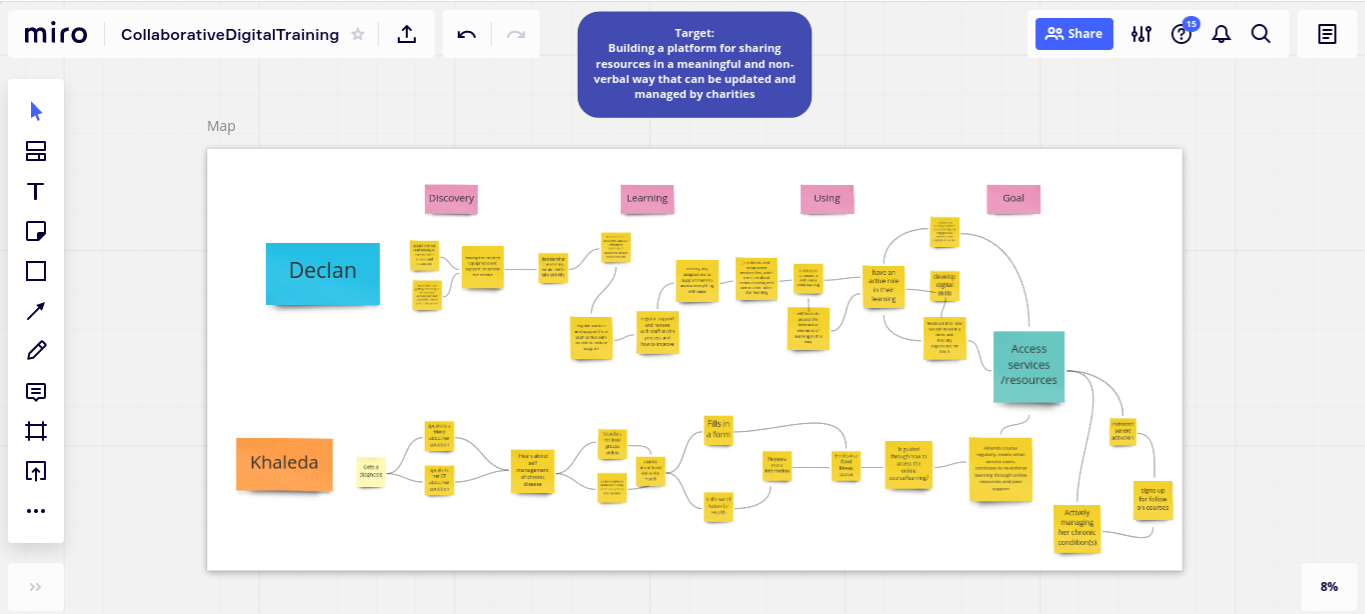

How to embed collaboration in the design process
Awdur: Gregor Thomson;
Amser Darllen: 4 munud
Mae hwn yn adnodd agored. Mae croeso i chi ei gopïo a'i addasu. Darllenwch y telerau.
Os hoffech gymorth pellach gyda'ch her ddigidol, trefnwch sesiwn am ddim gyda DigiCymru
Over the past six weeks, Founders and Coders have been delivering our Collaborative Digital Training Programme in partnership with CAST. Working closely with the two participating charities Social Action for Health and Pursuing Independent Paths throughout the progress has emphasised the strength of a collaborative approach to designing digital products. In this article, I’ll outline some of the ways we embed collaboration into our programme in order to create a product that can be implemented across the charity sector.
During the initial Discovery and Definition workshops, we run through a number of exercises that bring us to a common understanding of the problem area both charities are working within and identify a common goal which responds to the needs of the independent user groups of each charity. In these early stages, building collaboration and identifying commonality are central to our process. Every exercise is completed together either synchronously or with a shared focus. I will outline two specific exercises here, which illustrate how collaboration can be embedded into the design process.
During the initial stages of the programme, we focus on the user group we’re building for, what their goals are and how they behave. Each charity’s lead contact will be a Product Manager throughout the sprints – their responsibilities include holding the strategic vision, bringing domain expertise and leading the development team. Each Product Manager will fill in a User Persona, which gives detail on each of these categories. Charities work independently – but simultaneously – to document a representation of their particular users. Taking time to think individually gives each organisation space to think about the problems their users face and the challenges of building something which addresses the needs of those users. Once completed, each Product Manager reads their User Persona back to the collective group, giving a picture of their user to our developers and the other participating Product Manager/s. Everyone gains a clear and common understanding from documenting individually and sharing together.

Our next step is to map the path for our users to reach the shared goal decided amongst all organisations engaged in the sprint. Using a large frame on the online whiteboarding platform Miro, we list the users on the left hand side and the goal on the right hand side. Although each Product Manager is drawing the path for their individual personification of their user group, they are working to find a path for these distinct groups of people to reach a common goal. During mapping it becomes clear where commonality lies, in terms of how distinct groups of users will find the digital service, use it and accomplish their goal. Often, two distinct groups of users will follow a similar path to accomplish their goal. Designing a path for both groups opens up the accessibility of the app and ensures we’re designing for a diverse range of users.
Another key factor to fostering collaboration is the use of a shared space to complete exercises. Having organisations work next to one another on a Miro board emphasises that the sprint is about achieving something together through finding common ground. For example, moving from working on individual User Personas to mapping in a shared space moves the focus from specific reflections to a collaborative mindframe.
In conclusion, in order to encourage collaboration between charitable organisations we must provide opportunities for reflection, followed by synthesis and shared working. Throughout the process of deciding on a challenge to tackle and identifying the relevant users, we’re emphasising that distinct user groups can approach a shared solution from alternative perspectives – and the same solution can address both sets of users’ mutual challenges. Working alone and working together are integrated in a harmony which can be harnessed to provide effective and mutual solutions to the challenges faced by service users.
Wedi'i gomisiynu gan Catalyst
